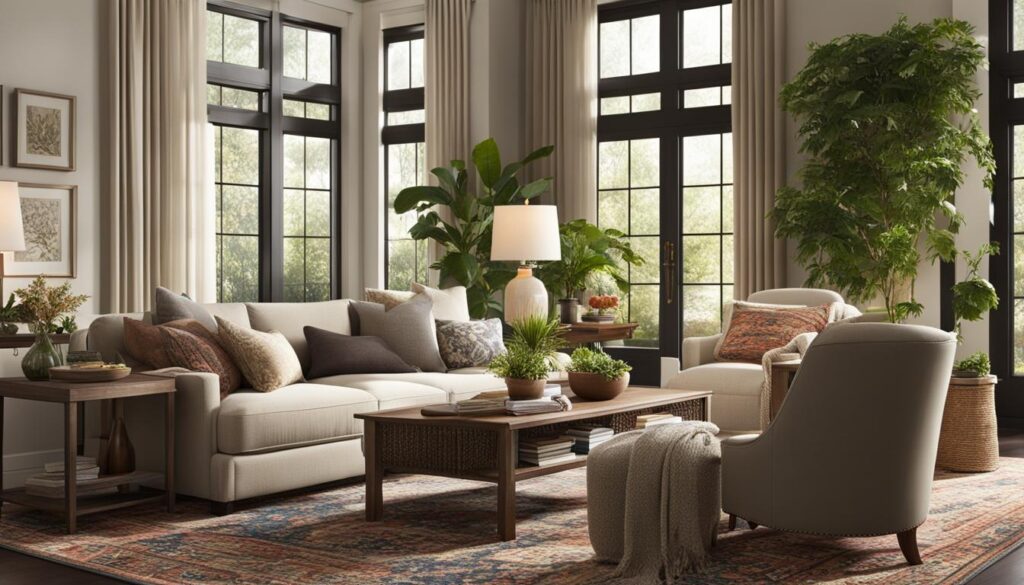The living room is an essential space in any apartment, serving as the heart of the home. It is where family members gather, guests are entertained, and relaxation takes place. When furnishing a living room, several key furniture pieces are commonly found to create a functional and inviting atmosphere.
One of the most essential pieces of living room furniture is the sofa. The sofa serves as the centerpiece, providing a comfortable seating area for family members and guests. It is where people can sit back, relax, and enjoy their favorite TV shows or engage in conversations.
In addition to the sofa, another common piece of living room furniture is the coffee table. The coffee table not only acts as a practical surface to place drinks and snacks, but it also adds a touch of style to the room. It can be used as a focal point for decorative items or a gathering spot for board games and activities.
Accent chairs are also frequently found in living rooms. These chairs serve as additional seating options and help create cozy corners for engaging conversations with guests. They come in various styles and designs, allowing homeowners to add their own personal touch to the room.
When it comes to traditional living room furniture, it’s common to see other decorative items such as rugs, pillows, and plants. These elements add color, style, and personality to the living room, making it feel warm and inviting.

Table of Contents
Key Takeaways:
- Living rooms typically include a sofa, coffee table, and accent chairs as essential furniture pieces.
- The sofa is the heart of the living room, providing a place to relax and watch TV.
- A coffee table is important for holding drinks, snacks, and as a decorative focal point.
- Accent chairs create cozy corners for conversations with guests.
- Rugs, pillows, and plants add color, style, and personality to the living room.
How to Arrange Living Room Furniture
Arranging furniture in a living room is an art that can transform the space into a functional and visually appealing area. Whether you have a small or large living room, the key is to optimize the layout to promote conversation, comfort, and flow. Here are some furniture arrangement tips to help you make the most of your living room:
- Start with the largest piece: Begin by positioning the largest furniture piece, such as the sofa, in a way that it faces the room’s focal point. This could be a fireplace, TV, or a beautiful view from the window. Arrange other seating options, like chairs or love seats, opposite or adjacent to the main piece to create an inviting conversation area.
- Add accent furniture strategically: Fill the space with accent furniture such as coffee tables, end tables, and lamps. Place the coffee table within easy reach of the seating area, providing a convenient spot to rest drinks, snacks, and books. End tables can be placed next to the sofa or chairs for holding lamps or decorative items.
- Create zones within a large living room: If you have a spacious living room, divide it into separate zones for different activities. Consider setting up a dedicated dining area with a table and chairs, a cozy reading nook with a comfortable armchair and a bookshelf, or a game area with a table for board games.
- Consider size and traffic flow: Take into account the size of your living room and the flow of traffic within the space. Arrange furniture in a way that allows easy movement and avoids blocking pathways. If you have limited space, opt for furniture that is proportionate to the room to avoid overcrowding.
Remember to incorporate your personal style and preferences when arranging furniture in your living room. Experiment with different layouts until you find the one that suits your needs and enhances the overall ambiance of the space.
Proper furniture arrangement can make a significant difference in the functionality and aesthetic appeal of a living room. By following these tips and considering the size, focal points, and traffic flow, you can create a well-designed living room layout that is both practical and visually pleasing.
Table: Furniture Arrangement Tips
| Tip | Description |
|---|---|
| Start with the largest piece | Position the largest furniture piece, such as a sofa, facing the room’s focal point. |
| Add accent furniture strategically | Fill the space with coffee tables, end tables, and lamps to enhance functionality. |
| Create zones within a large living room | Divide the space into separate zones for different activities, such as dining, reading, or gaming. |
| Consider size and traffic flow | Arrange furniture to ensure easy movement and avoid blocking pathways. |
Conclusion
As we conclude our living room furniture guide, we have learned that furnishing a living room involves selecting essential furniture pieces and arranging them in a way that best suits the space and desired functionality. A complete living room setup typically includes a sofa, coffee table, accent chairs, and various decor items.
Proper furniture arrangement is essential to enhance the aesthetic appeal and functionality of the living room. By considering the room’s size, focal points, and traffic flow, you can create a layout that promotes comfort and ease of movement. Additionally, incorporating personal style and preferences when selecting decor items allows you to infuse your unique touch into the space.
Remember, a functional living room is a dynamic space that can evolve over time. Regularly evaluating and adjusting the furniture arrangement ensures that it continues to meet your needs and provides maximum comfort. With careful planning and consideration, you can transform your living room into a welcoming, cozy, and functional space that reflects your personal style.
FAQ
What furniture is usually in a living room?
The essential furniture pieces commonly found in a living room are a sofa, coffee table, and accent chairs.
How do I arrange living room furniture?
When arranging living room furniture, start with the largest piece, such as the sofa, and orient it towards the room’s focal point. Position smaller seating options, like chairs or love seats, opposite or adjacent to the main piece. Fill the space with accent furniture, such as coffee tables, end tables, and lamps.
How can I incorporate personal style into my living room?
You can incorporate personal style by selecting decor items that reflect your preferences, such as rugs, pillows, and plants. These items add color, style, and personality to the living room.
What should I consider when arranging furniture in a living room?
Consider the size of the room and create a layout that promotes conversation and easy movement. Take into account the room’s architecture and natural focal points, such as a fireplace or bay window, when positioning furniture. Pay attention to the flow of traffic in the room and place furniture accordingly.
How often should I evaluate and adjust the furniture arrangement in my living room?
Regularly evaluate and adjust the furniture arrangement to ensure functionality and comfort. As your needs and preferences change over time, it’s important to adapt the layout accordingly.
How can I divide a large living room into separate zones?
To divide a large living room into separate zones, you can create different areas for activities like dining and conversation. Use furniture placement, such as sofas or bookshelves, to create visual boundaries and define each zone.
What is the importance of furniture arrangement in a living room?
Proper furniture arrangement enhances the aesthetic appeal and functionality of the living room. It creates a cohesive and inviting space where people can gather, relax, and enjoy various activities.



